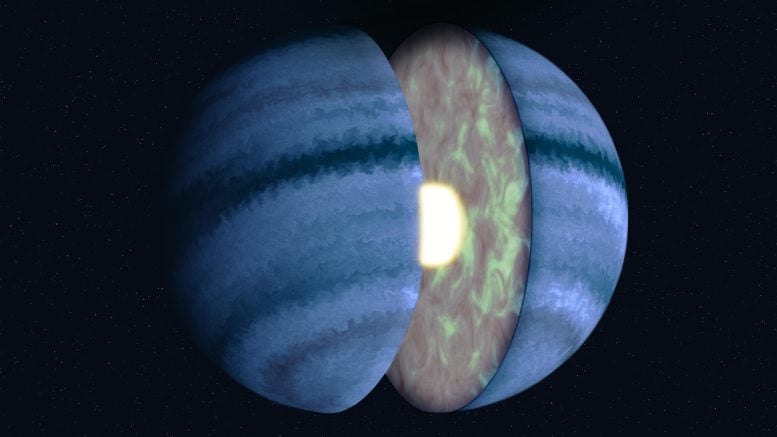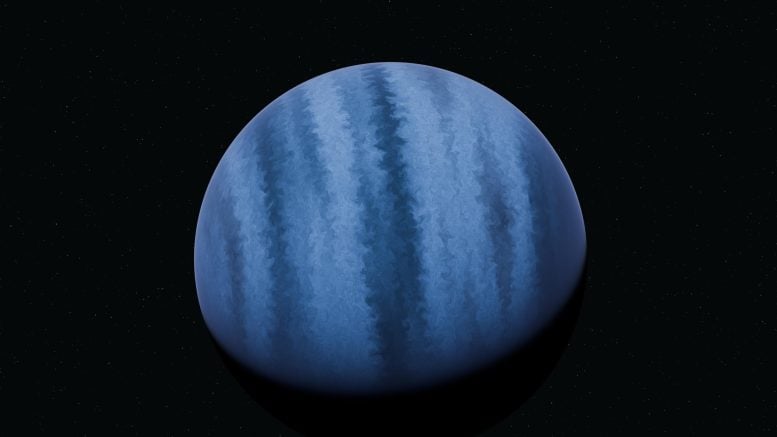
An artist’s impression of WASP-107 b shows turbulent atmospheric mixing within the planet’s gaseous envelope. Credit: Roberto Molar Candanosa/Johns Hopkins University

Artist’s impression of WASP-107 b, a hot exoplanet of Neptune located about 200 light years away. Credit: Roberto Molar Candanosa/Johns Hopkins University
Planetary composition and habitability potential
A giant planet enveloped by a steamy, cotton-soft atmosphere, WASP-107 b orbits a star located about 200 light years away. He is bloated because of his build: a
” data-gt-translate-attributes=”({“attribute”:”data-cmtooltip”, “format”:”html”})” tabindex=”0″ role=”link”>Jupitera medium-sized world with only a tenth of the mass of this planet.
Although it contains methane – a building block of life on Earth – the planet is not considered habitable due to its proximity to its parent star and lack of a solid surface. But it could hold important clues about late-stage planetary evolution.
Mysteries of methane and chemical dynamics
In a separate study published in Natureother scientists also spotted methane with the Webb telescope and provided similar information about the planet’s size and density.
“We want to study planets more similar to the gas giants in our own solar system, which have a lot of methane in their atmospheres,” Sing said. “That’s where the WASP-107 b story got really interesting, because we didn’t know why the methane levels were so low.”
The new methane measurements suggest that the molecule transforms into other compounds as it rises from the planet’s interior, interacting with a concoction of other chemicals and starlight in the upper atmosphere . The team also measured sulfur dioxide, water vapor, carbon dioxide and carbon monoxide and found that WASP-107 b contains more heavy elements than
” data-gt-translate-attributes=”({“attribute”:”data-cmtooltip”, “format”:”html”})” tabindex=”0″ role=”link”>Uranus And
” data-gt-translate-attributes=”({“attribute”:”data-cmtooltip”, “format”:”html”})” tabindex=”0″ role=”link”>Neptune.
Observational studies and future research
The profile of the planet’s chemistry is beginning to reveal key pieces of the puzzle of how planetary atmospheres behave under extreme conditions, Sing said. His team will carry out similar observations over the next year on 25 additional planets with the Webb telescope.
“We have never been able to study this mixing process in detail in an exoplanet’s atmosphere, so this will go a long way toward understanding how these dynamic chemical reactions work,” Sing said. “This is something we definitely need as we start to study rocky planets and biomarker signatures.”
Internal heat sources and atmospheric effects
Scientists had hypothesized that the planet’s overly inflated radius was the result of a heat source inside, said Zafar Rustamkulov, a doctoral student in planetary sciences at Johns Hopkins University who co-led the research. By combining atmospheric and interior physics models with Webb’s data on WASP-107 b, the team explained how the planet’s thermodynamics influence its observable atmosphere.
“The planet has a hot core, and that heat source changes the gas chemistry deep down, but it also drives this strong convective mixing that bubbles up from the interior,” Rustamkulov said. “We believe this heat changes the chemistry of the gases, specifically destroying methane and producing high amounts of carbon dioxide and carbon monoxide.”
Current investigations and future experiments
The new findings also represent the clearest link scientists have yet been able to make between an exoplanet’s interior and the top of its atmosphere, Rustamkulov said. Last year, the Webb telescope spotted sulfur dioxide about 700 light years away on another exoplanet called WASP-39, providing the first evidence of an atmospheric compound created by reactions driven by starlight.
The Johns Hopkins team is now focusing on what might keep the core warm and expects forces similar to those that cause high and low tides in Earth’s oceans to be at play. They plan to test whether the planet is stretched and pulled by its star and how this could explain the high heat of the core.
The references:
“Methane from a Hot Neptune Reveals Central Mass and Vigorous Atmospheric Mixing” by David K. Sing, Zafar Rustamkulov, Daniel P. Thorngren, Joanna K. Barstow, Pascal Tremblin, Catarina Alves de Oliveira, Tracy L. Beck, Stephan M. Birkmann, Ryan C. Challener, Nicolas Crouzet, Néstor Espinoza, Pierre Ferruit, Giovanna Giardino, Amélie Gressier, Elspeth KH Lee, Nikole K. Lewis, Roberto Maiolino, Elena Manjavacas, Bernard J. Rauscher, Marco Sirianni and Jeff A . Valenti, May 20, 2024, Nature.
DOI: 10.1038/s41586-024-07395-z
“High internal heat flux and a large core in a hot Neptune exoplanet” by Luis Welbanks, Taylor J. Bell, Thomas G. Beatty, Michael R. Line, Kazumasa Ohno, Jonathan J. Fortney, Everett Schlawin, Thomas P. Greene, Emily Rauscher, Peter McGill, Matthew Murphy, Vivien Parmentier, Yao Tang, Isaac Edelman, Sagnick Mukherjee, Lindsey S. Wiser, Pierre-Olivier Lagage, Achrène Dyrek and Kenneth E. Arnold, May 20, 2024, Nature.
DOI: 10.1038/s41586-024-07514-w
Other authors of the study are Daniel P. Thorngren and Elena Manjavacas of Johns Hopkins University; Joanna K. Barstow of the Open University; Pascal Tremblin of Paris-Saclay University; Catarina Alves de Oliveira, Stephan M. Birkmann and Pierre Ferruit of
” data-gt-translate-attributes=”({“attribute”:”data-cmtooltip”, “format”:”html”})” tabindex=”0″ role=”link”>European Space Agency; Tracy L. Beck, Néstor Espinoza, Amélie Gressier, Marco Sirianni and Jeff A. Valenti of the Space Telescope Science Institute; Ryan C. Challener of Cornell University; Nicolas Crouzet, Giovanna Giardino and Nikole K. Lewis of Leiden University; Elspeth KH Lee; Roberto Maiolino of the University of Cambridge; and Bernard J. Rauscher of
” data-gt-translate-attributes=”({“attribute”:”data-cmtooltip”, “format”:”html”})” tabindex=”0″ role=”link”>NASA Goddard Space Flight Center.
This research is based on data obtained from the Space Telescope Science Institute, which is operated by the Association of Universities for Research in Astronomy Inc., under NASA contract NAS 5-03127.